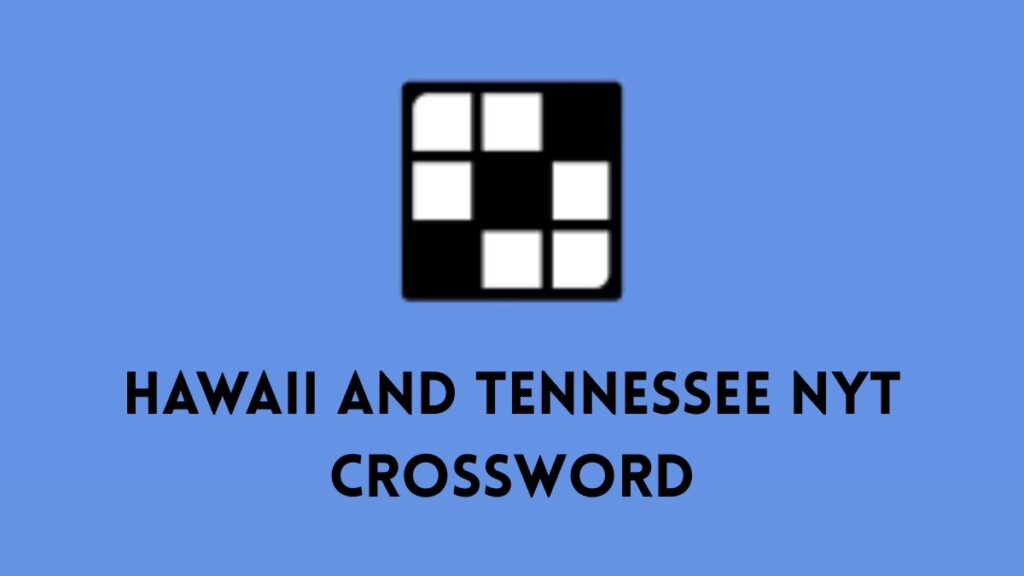✦ Intro: When Crossword Clues Go Rogue
It’s the kind of clue that sends even the most seasoned cruciverbalists spiraling: “Hawaii and Tennessee NYT Crossword.” Just four words. But in the high-stakes puzzle arena that is the New York Times Crossword, those four words punch far above their weight.
Panic sets in. The coffee cools. Brows furrow. A whisper: “What do Hawaii and Tennessee have in common?” You look at the grid. Six letters. Then seven. Then five. Variants abound. Is this a geography question? A political one? Or—classic NYT mischief—is this yet another linguistic red herring?
Welcome to the world of layered wordplay, where nothing means exactly what it says and every clue is a cipher dressed up as trivia. In this deep dive, we’ll crack the mystery wide open—Hawaii and Tennessee NYT Crossword Clue Explained Brilliantly, from history to syntax to the sly humor only Will Shortz and his ilk could conjure.
✦ Section I: The Clue That Launched a Thousand Googles
The New York Times crossword is no ordinary pastime. It’s a cultural institution, a brainy badge of honor, and sometimes, a test of whether you think laterally enough to be considered human.
So when the clue “Hawaii and Tennessee” showed up in puzzles—sometimes separately, sometimes paired—it ignited forums, Reddit threads, and casual coffee shop wars.
Here’s the thing: It’s not really about the states.
Let’s break this down, brilliantly.
✦ Section II: Surface Meaning vs. Cryptic Depth
At face value, Hawaii and Tennessee don’t have a lot in common. One’s a volcanic island paradise floating in the Pacific. The other is a landlocked Southern state with whiskey roots and country soul. Politically, culturally, geographically—they’re oil and water.
Which is exactly what makes the clue so… suspicious.
What seasoned solvers know (and casual players soon learn) is that when the NYT pairs seemingly unrelated items in a clue, there’s usually a deeper, structural, or linguistic link. Think anagram, abbreviation, shared suffix, or sly pun.
This is where things get devious.
✦ Section III: The Common Denominator—State Abbreviations
Let’s spotlight the most frequent answer pattern associated with the “Hawaii and Tennessee” clue:
“STATES”
That’s it. Simple. Clean. Ironic.
Why?
Because the clue isn’t really asking what Hawaii and Tennessee are. It’s asking what category they belong to.
Both are U.S. states. Sometimes, the NYT plays it that straight. But other times, the answer might be “TWO,” “PAIR,” or “ST ABBREVS” (for state abbreviations, a sly meta answer). It’s not just about knowing the states, it’s about seeing through the riddle.
One example clue/answer pairing:
Clue: Hawaii and Tennessee, e.g.
Answer: STATES
Another might go:
Clue: HI and TN
Answer: ABBREVS
And here’s where solvers get tripped up. They’re looking for specific details—capitals, flags, even postal codes—when the answer is a zoomed-out category. This is a lexical trap, NYT style.
✦ Section IV: When Hawaii and Tennessee = Musical Clue
Another brilliant twist? Music.
The New York Times Crossword clue “Hawaii and Tennessee” has occasionally been a nod to musical genres or associations. Think:
-
Ukulele for Hawaii
-
Country or Blues for Tennessee (especially given Nashville and Memphis)
It’s not always the obvious link. A deeper version of the clue might be:
Clue: Music traditions of Hawaii and Tennessee
Answer: STRINGS
Guitar, banjo, ukulele—all string instruments. All rooted in their respective cultural traditions. Now that’s sly.
✦ Section V: Cryptic Crossover—A British Twist on NYT Wordplay
Occasionally, the New York Times dips its toes into cryptic crossword territory—clues with double meanings or indirect definitions. And “Hawaii and Tennessee” is ripe for such treatment.
Let’s take a cryptic-style reworking of the clue:
Clue: HI and TN, for example (6)
Answer: STATES
Why does this work?
Because HI and TN are abbreviations for states—but also, the clue mimics the structure of cryptic puzzles. The “for example” acts as an indicator that the answer is a category. It’s crosswordese with a nod to Her Majesty’s favorite pastime.
✦ Section VI: Clue Evolution—Same Words, New Trick
One of the reasons the clue “Hawaii and Tennessee” endures is because it can be adapted, reframed, and recontextualized endlessly. The NYT crossword evolves, and so does its misdirection.
Here are some ways the same clue has been remixed:
-
Clue: Hawaii and Tennessee, e.g.
Answer: STATES -
Clue: What HI and TN are
Answer: POSTALCODES -
Clue: Pair of state IDs
Answer: HI, TN -
Clue: Hawaii and Tennessee’s shared trait
Answer: ABBR (short for abbreviation) -
Clue: Hawaii and Tennessee, to geographers
Answer: USSTATES
Each time, the twist changes. Sometimes it’s linguistic. Sometimes taxonomic. Sometimes symbolic.
But every time? It’s brilliant.
✦ Section VII: Community Buzz—Why Solvers Obsess Over This Clue
Reddit’s r/crossword is no stranger to meltdowns over the “Hawaii and Tennessee” prompt.
One user wrote:
“This clue wrecked me for 20 minutes. I thought I was solving for capitals or flowers or freaking time zones. Turns out… just STATES. I hate it. I love it.”
Another:
“I saw HI and TN and was convinced it was some kind of periodic table joke. Chemistry brain activated. Turns out, I needed postal logic.”
These reactions aren’t just entertainment—they’re proof that the clue’s simplicity is deceptive. It’s a masterclass in minimalism, a wink to those who overthink and a nod to those who trust the grid.
✦ Section VIII: Puzzle Philosophy—Why the NYT Loves This Move
There’s a reason this clue keeps showing up in various forms.
It’s not just a clever moment. It’s a design philosophy.
The NYT crossword thrives on layered meaning. The best clues:
-
Reward knowledge
-
Trick with ambiguity
-
Force lateral thinking
-
Deliver an “aha” payoff
“Hawaii and Tennessee” is the perfect vessel for all four.
It dances between literal and figurative, between the surface and the sly. It showcases what makes The New York Times Crossword less a puzzle and more a linguistic dojo.
✦ Section IX: Tips for Solving Clues Like “Hawaii and Tennessee”
If this clue drove you mad, you’re not alone. But the next time you see something like it, try this mental checklist:
-
Zoom out. Is the clue referring to a category, not specifics?
-
Think abbreviation. Could it be referencing postal codes or acronyms?
-
Ask what they are, not what they do. Hawaii and Tennessee don’t need to interact. They just need to exist.
-
Scan for misdirection. Could the clue be using “and” as a connector or a smokescreen?
-
Count the squares. The number of letters is always a cheat code. Six squares = probably “STATES.” Seven? Maybe “REGIONS.” Nine? Could be “POSTALCODES.”
Pattern recognition, not trivia retention, is your weapon.
✦ Section X: In Crossword We Trust
The New York Times Crossword is less about solving and more about storytelling. Every clue is a character. Every answer a revelation. And “Hawaii and Tennessee”? That’s one of the greatest plot twists in the game.
So the next time you see it—breathe. Smile. Remember this article. Say it with us:
Hawaii and Tennessee NYT Crossword Clue Explained Brilliantly.
Because it was never about geography.
It was about seeing the forest and the trees.
✦ TL;DR Recap: What You Need to Know
| Clue | Possible Answers | Explanation |
|---|---|---|
| Hawaii and Tennessee | STATES | They are both U.S. states |
| HI and TN | ABBR / POSTALCODES | Postal abbreviations |
| What they have in common | USSTATES / PAIR | Category logic |
| Clue with musical bent | STRINGS | Cultural references |
| Cryptic twist | ST ABBREVS | Meta-level answer |
✦ Final Thought: The Real Puzzle Piece
At the end of the day, it’s not just about Hawaii. Or Tennessee. Or postal codes or categories.
It’s about the moment you finally get it. That brain-tingling realization.
Because “Hawaii and Tennessee NYT Crossword Clue Explained Brilliantly” is more than a title. It’s a mantra for every puzzle-lover who’s ever second-guessed a clue… and triumphed.
And now?
You’re one of them.






